 W
WThe Las Piñas Bamboo Organ in St. Joseph Parish Church in Las Piñas City, Philippines, is a 19th-century church organ with unique organ pipes; Of its 1031 pipes 902 are made of bamboo. It was completed after 6 years of work in 1824 by Father Diego Cera, the builder of the town's stone church and its first resident Catholic parish priest.
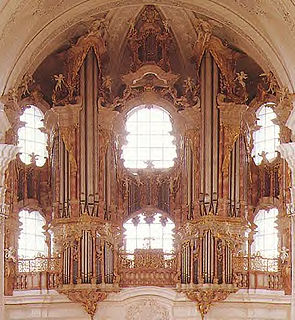 W
WThe organ at the Basilica of St. Martin (Weingarten), the monastery church of the Weingarten Abbey was built by Joseph Gabler between 1737 and 1750. In addition to the large organ he also built the small choir organ in 1743, but this has since been renovated or completely rebuilt.
 W
WThe Berliner Philharmonie is a concert hall in Berlin, Germany, and home to the Berlin Philharmonic Orchestra.
 W
WThe Boardwalk Hall Auditorium Organ is the pipe organ in the Main Auditorium of the Boardwalk Hall in Atlantic City, New Jersey, built by the Midmer-Losh Organ Company. It is the largest organ in the world, as measured by the number of pipes.
 W
WCasavant Frères Ltée. Opus 1841 is a pipe organ built by the famous Casavant Frères of Saint-Hyacinthe, Quebec. The organ was first completed in 1911 as Casavant Brothers - Opus 452 for St. Andrew's Presbyterian Church at 40 Bentinck Street, Sydney, Nova Scotia, Canada. St. Andrew's later became St. Andrew's United Church and is now the Highland Arts Theatre.
 W
WThe organs of Cologne Cathedral are the major source of instrumental music at the cathedral, being played for daily services and accompanying the choir, as well as being used for concerts and recitals.
 W
WThe Hazel Wright Organ is an American pipe organ located in Christ Cathedral in Garden Grove, California. It is one of the world's largest pipe organs. As of 2019, it has 293 ranks and 17,106 pipes, fully playable from two 5-manual consoles.
 W
WThe Galston Uniting Church Pipe Organ or Pipe Organ from Bourke Street Congregational Church is a heritage-listed church pipe organ located at 11 School Road, Galston in the Hornsby Shire local government area of New South Wales, Australia. It was built by Forster and Andrews. It is also known as Pipe Organ from Bourke Street Congregational Church (former) and Forster and Andrews Pipe Organ; Galston Uniting Church Pipe Organ. The property is owned by Uniting Church in Australia. It was added to the New South Wales State Heritage Register on 2 April 1999.
 W
WThe Hollywood High School E. M. Skinner Organ Opus 481-A is a pipe organ in Hollywood High School, in Hollywood, Los Angeles, California. The contract for Opus 481 was made in June 1924, shortly after Skinner returned from his second trip to England and France. It took two years to build the organ. The organ was expanded in 1929 by Skinner. When the 1929 Memorial auditorium was built, the organ was moved and also registered as Opus 481-A. Then in 1954 it was placed into storage when the auditorium was refurbished, torn down to its foundation and rebuilt in its present form. Opus 481 is considered to be of musical value, built by the "Cadillac" of symphonic organ builders of the 20th century. The historic organ is an E. M. Skinner Opus 481 of 3-manuals, 39 ranks with chimes and has over 2,600 pipes.
 W
WThe Gloger Organ in Kongsberg Church in Kongsberg, Norway was built by Gottfried Heinrich Gloger in 1765. Because of damage caused by a fire, the organ was disused from the end of the 19th century.
 W
WThe Kotzschmar Memorial Organ, usually referred to as the Kotzschmar Organ, is a pipe organ located at Merrill Auditorium in the City Hall of Portland, Maine, United States. Built in 1911 by the Austin Organ Co. as Opus 323, it was the second-largest organ in the world at the time, and it remains the largest organ in Maine today.
 W
WThe Kulturpalast Dresden is a modernist building built by Wolfgang Hänsch during the era of the German Democratic Republic. It was the largest multi-purpose hall in Dresden when it opened in 1969, and was used for concerts, dances, conferences and other events. The building underwent several years of reconstruction beginning in 2012 and opened with a new concert hall in April 2017.
 W
WMethuen Memorial Music Hall, initially named Searles Organ Hall, was built by Edward Francis Searles to house "The Great Organ", a very large pipe organ that had been built for the Boston Music Hall. The hall was completed in 1909, and stands at 192 Broadway in Methuen, Massachusetts.
 W
WThe great organ of the cathedral of Nancy was begun in 1756. It is placed on a gallery above the central doorway of the Notre-Dame-de-l'Annonciation cathedral in Nancy.
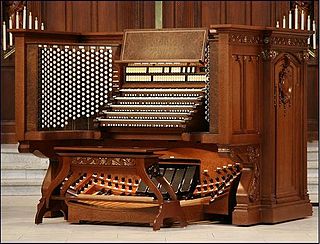 W
WThe Naval Academy Chapel Organ is located in the United States Naval Academy Chapel in Annapolis, Maryland. The original instrument was built in 1908 by The Hutchings-Votey Organ Company of Boston, Massachusetts. When the chapel underwent remodeling in 1940, the M.P. Moller Pipe Organ Company of Hagerstown, Maryland was contracted to build a larger instrument to support music in the newly enlarged building. Through the generous gifts of various Naval Academy classes, the organ has undergone a number of enhancements and renovations. The current instrument, comprising both pipe and digital voices, totals 268 ranks and is controlled by two consoles.
 W
WThe Newberry Memorial Organ is among the largest and most notable symphonic organs in the world. Located in Woolsey Hall at Yale University, the organ contains 197 ranks and 166 stops comprising 12,617 pipes.
 W
WThe organ of the Dorpskerk in Noordbroek in the Dutch province of Groningen was first built in 1696 by Arp Schnitger. Today it has 24 stops over two manuals and pedal. The case and the disposition are largely preserved as they were in 1809.
 W
WThe west gallery organ in the Aa-kerk in Groningen was built by Arp Schnitger in 1699–1702. Originally built for the Academiekerk in Groningen it was moved to the Aa-kerk in 1815. Today it has 40 stops on three manuals and pedal, and is a momument of European significance.
 W
WThe Jacobikerk organ in Uithuizen in the Dutch province of Groningen was built in 1701 by Arp Schnitger. It has 28 stops which are distributed on two manuals and pedal. The instrument is one of the best preserved Schnitger organs. The organ has been used as a template for newly built organs in the 20th century and for the reconstruction of lost stops of other Schnitger organs.
 W
WThe west gallery organ of the Martinikerk in Groningen dates from the 15th century; it took its present form in the 18th century when it was expanded by Arp Schnitger, his son Franz Caspar Schnitger and his successor Albertus Antonius Hinsz. It has 52 speaking stops on three manuals and pedal, and is one of the largest and most famous baroque organs in Northern Europe.
 W
WThe organ of St. Ludgeri in Norden was built from 1686 to 1692 by Arp Schnitger. It has 46 stops, five divisions, three manuals and pedal, and is thus the second-largest surviving Schnitger organ in Germany and until 2018 the largest organ in East Frisia. Historically and musically it is considered an art-work of international rank.
 W
WThe organ of the St. Pankratius in Hamburg-Neuenfelde was built in 1688 by Arp Schnitger, and is his largest two-manual organ. The instrument has 34 stops, of which about half are original. Neuenfelde itself belongs to the Altes Land and was incorporated to Hamburg in 1937.
 W
WThe organ of St. Peter and Paul in Cappel was built in 1680 by Arp Schnitger for the St. Johannis-Klosterkirche in Hamburg and has been in Cappel, Lower Saxony since 1816. It is considered to be the most complete and sonically best-preserved organ from the late 17th century in northern Germany. The instrument has two manuals with pedal and 30 stops, of which only two are not entirely old. Helmut Walcha's recordings of Bach's organ works (1950–1952) made this instrument world-famous.
 W
WThe organ of the Grasberg church, or Findorffkirche, in Grasberg was built in 1693–1694 by Arp Schnitger, originally for the orphanage at Rödingsmarkt in Hamburg, and transferred to Grasberg in 1788. It is one of the few instruments by Schnitger to have been structurally changed as early as the 18th century. The organ has 21 stops, over two manuals and pedal. 15 stops are still original Schnitger work.
 W
WThe North German baroque organ in Örgryte Nya Kyrka is a pipe organ in Gothenburg, Sweden. It was built within a research project at GOArt, University of Gothenburg and dedicated on August 12, 2000. The goal of the project was to recreate the construction techniques and design philosophies of 17th-century German organbuilder Arp Schnitger. Even though the instrument was built in the style of this single builder it was not modeled after a single instrument. No single model could be used since no large Schnitger organ has been preserved in original condition. The construction of the organ was carried out by an international team of organ builders. Henk van Eeken was responsible for the design and the technical drawings, Munetaka Yokota for the pipe work and Mats Arvidsson oversaw the building process. The instrument contains almost 4000 pipes and is the largest existing organ tuned in quarter-comma meantone.
 W
WThe six organs in the Basilica of the Palace of Mafra - designed and built all at the same time, and designed to play together as well - were built by the two most important Portuguese organ builders of the time – António Xavier Machado e Cerveira and Joaquim António Peres Fontanes – and were completed between 1806 and 1807. The last two were inaugurated on 4 October 1807, and a substantial number of compositions involving all six organs were produced that year.
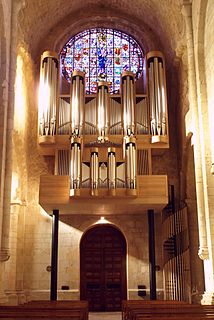 W
WThe organ of Poblet is a three manual, 56 stop pipe organ installed in the church of the Abbey of Santa Maria of Poblet. It was built in 2012 by the Swiss firm Metzler Orgelbau AG.
 W
WDome Pipe Organ, the second largest pipe organ in Latvia, is located in Riga Cathedral. The largest mechanical pipe organ in Latvia is located in Liepāja Holy Trinity Cathedral.
 W
WThe Grand Organ situated in the Royal Albert Hall in London is the second largest pipe organ in the United Kingdom, after the Liverpool Cathedral Grand Organ. It was originally built by Henry "Father" Willis and most recently rebuilt by Mander Organs, having 147 stops and, since the 2004 restoration, 9,999 pipes.
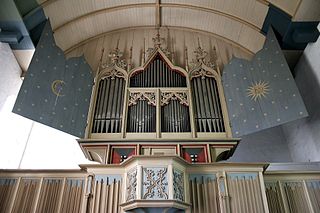 W
WThe Rysum organ in Rysum Church in Rysum, north Germany, is the oldest instrument of its kind in northern Europe that still largely has its original pipes. It is also one of the oldest playable church organs in the world alongside those in Sion, St. Valentin in Kiedrich, and Ostönnen. It was originally built in 1457 and rebuilt in 1513. After undergoing several other modifications through the years it was restored to its 1513 condition by Jürgen Ahrend and Gerhard Brunzema in 1959. The organ has seven organ stops on one keyboard.
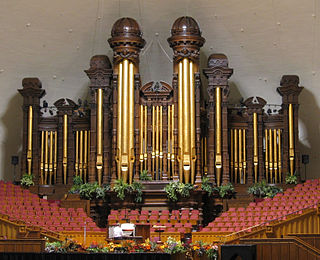 W
WThe Salt Lake Tabernacle organ is a pipe organ located in the Salt Lake Tabernacle in Salt Lake City, Utah. Along with the nearby Conference Center organ, it is typically used to accompany The Tabernacle Choir at Temple Square and is also featured in daily noon recitals. It is one of the largest organs in the world. Schoenstein & Co. President and tonal director Jack Bethards describes it as an "American classic organ" and "probably one of the most perfect organs ever built."
 W
WThe Schoenstein Organ at the Conference Center is a pipe organ built by Schoenstein & Co., San Francisco, California located in the Conference Center of The Church of Jesus Christ of Latter-day Saints in Salt Lake City, Utah. The organ was completed in 2003. It is composed of 160 speaking stops spread over five manuals and pedals. Along with the nearby Salt Lake Tabernacle organ, it is typically used to accompany the Tabernacle Choir at Temple Square. Schoenstein & Co.'s president and tonal director, Jack Bethards, describes it as "an American Romantic organ" that is "probably more English than anything else."
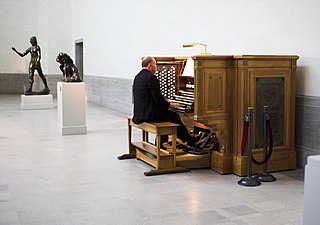 W
WThe Spreckels Organ is a pipe organ that was designed by Ernest M. Skinner. It was installed in 1924 at the Legion of Honor museum in San Francisco, California. Public performances are held on Saturdays, 4:00–4:45 pm.
 W
WThe organ in St. Jacobi Church, Hamburg, was built in 1689 – 1693 by the renowned organ builder Arp Schnitger. The organ boasts four manuals and pedal with 60 stops -- of which 15 are reeds -- and totalling approximately 4000 sounding pipes. All in all, from the organ's original installation and its condition today not much of its conception has changed. The old pipework and the prospect pipes have been preserved in almost original format. This is the largest organ in existence from before 1700 and is one of the most eminent Baroque instruments that have been preserved.
 W
WSpreckels Organ Pavilion houses the open-air Spreckels Organ in Balboa Park, San Diego, California. The Spreckels Organ is the world's largest pipe organ in a fully outdoor venue. Constructed for the 1915 Panama-California Exposition, it is located at the corner of President's Way and Pan American Road East in the park.
 W
WThe Sydney Opera House Grand Organ is the world's largest mechanical tracker-action pipe organ. It is located in the concert hall of Sydney Opera House in Sydney, Australia, and was designed by Ronald Sharp, who was assisted by Mark Fisher, Myk Fairhurst and Raymond Bridge.
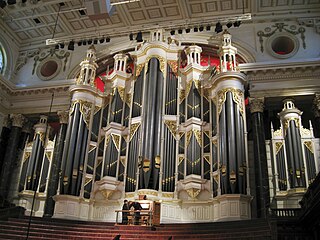 W
WThe Sydney Town Hall Grand Organ is a large pipe organ built by English firm William Hill & Son in 1890. It is located in the Centennial Hall of Sydney Town Hall in Sydney, New South Wales, Australia.
 W
WTipu's Tiger or Tippu's Tiger is an eighteenth-century automaton or mechanical toy created for Tipu Sultan, the ruler of the Kingdom of Mysore in India. The carved and painted wood casing represents a tiger savaging a near life-size European man. Mechanisms inside the tiger and man's bodies make one hand of the man move, emit a wailing sound from his mouth and grunts from the tiger. In addition a flap on the side of the tiger folds down to reveal the keyboard of a small pipe organ with 18 notes.
 W
WThe Wanamaker Grand Court Organ, in Philadelphia, is the largest pipe organ in the world, based on number of ranks and physical mass weight. The Wanamaker Organ is located within a spacious 7-story Grand Court at Macy's Center City and is played twice a day Monday through Saturday. The organ is featured at several special concerts held throughout the year, including events featuring the Friends of the Wanamaker Organ Festival Chorus and Brass Ensemble.
 W
W